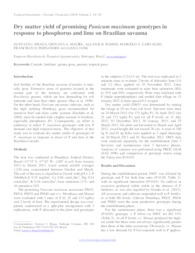Dry matter yield of promising Panicum maximum genotypes in response to phosphorus and lime on Brazilian savanna.
Dry matter yield of promising Panicum maximum genotypes in response to phosphorus and lime on Brazilian savanna.
Author(s): BRAGA, G. J.; MACIEL, G. A.; RAMOS, A. K. B.; CARVALHO, M. A.; FERNANDES, F. D.; JANK, L.
Summary: Soil fertility of the Brazilian savanna (Cerrado) is natu-rally poor. Extensive areas of pastures located in the central part of the territory are cultivated with Brachiaria grasses, which are less demanding for soil nutrients and lime than other species (Rao et al. 1998). On the other hand, Panicum maximum cultivars, such as the high yielding Mombaça grass recommended for intensive beef and dairy cattle systems (Euclides et al. 2008), must be seeded with a higher amount of fertilizer, especially phosphorus (P). Consequently, an effort is underway to select P. maximum genotypes with low P demand and high responsiveness. The objective of this study was to evaluate dry matter yields of genotypes of P. maximum in response to doses of P and lime in the Brazilian Cerrado.
Publication year: 2014
Types of publication: Journal article
Unit: Embrapa Beef Cattle
Observation
Some of Embrapa's publications are published as ePub files. To read them, use or download one of the following free software options to your computer or mobile device. Android: Google Play Books; IOS: iBooks; Windows and Linux: Calibre.
Access other publications
Access the Agricultural Research Database (BDPA) to consult Embrapa's full library collection and records.
Visit Embrapa Bookstore to purchase books and other publications sold by Embrapa.

